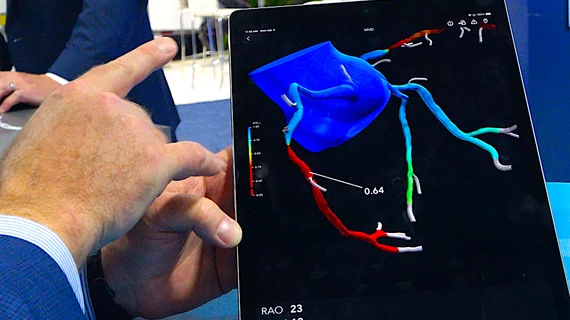FFR-CT helps determine when CAD patients face a limited risk of adverse outcomes within 3 years
New research out of Denmark suggests an advanced CT test may be able to identify when individuals with angina do not face a heightened risk of adverse outcomes within the next three years. The study's authors shared their findings in Radiology[1].
The new analysis shed light on the potential of CT angiography-derived fractional flow reserve (CT-FFR) to assess the potential impact of coronary artery disease on blood flow through the arteries, and how this measure can be predictive of negative outcomes.
Researchers assessed the three-year clinical outcomes of patients with new-onset stable angina pectoris. Eligible participants had at least one coronary artery stenosis (narrowing) greater than 30% and did not present with atrial fibrillation or prior coronary revascularization.
Of the 900 participants, researchers compared two groups: 523 patients with normal coronary CTA-derived FFR results and 377 with abnormal results. The study's primary endpoint was a combination of all-cause death and nonfatal spontaneous heart attack.
The findings revealed that 2.1% of participants with normal FFR results experienced adverse cardiac events, while the rate was notably higher (6.6%) among those with abnormal results. This difference translated into a relative risk of 3.1, signifying a significant association. The FFR test assesses blood flow in coronary arteries, particularly in the presence of stenosis. A value of 0.80 or below indicates an abnormal test result.
A coronary artery calcium (CAC) score is a measure of plaque buildup in the heart, and a score of 400 or more signals a level that may be restricting bloodflow. Among study participants with normal CT-FFR results and a high CAC score, the adverse outcome rate was 2.2%. Participants with a high CAC score and abnormal CT-FFR results experienced adverse outcomes at a rate of 9% over the three-year timeframe.
“Our study provides evidence for the prognostic potential of CT-FFR in patients with high CAC scores,” lead author Kristian T. Madsen, MD, PhD, with the University Hospital of Southern Denmark in Esbjerg, said in a statement. “Regardless of the patient’s baseline risk and extent of coronary artery disease measured by CAC, if CT-FFR results are normal, the prognosis is good.”
The increased risk of serious complications was significant for participants with coronary CTA-derived FFR of 0.80 or below compared to those with greater than 0.80. All-cause death occurred in 2.8% of participants, and myocardial infarction occurred in 1.3%, resulting in a total of 4.1% primary endpoint events.
“CT-FFR provides diagnostic and prognostic information beyond what can be obtained from CT angiography alone across a wide range of coronary artery calcium levels,” Madsen said. “It’s a tool that offers a lot of exciting prospects for the future.”

